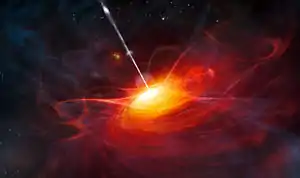SN 2011dh
SN 2011dh is a supernova in the Whirlpool Galaxy (M51). On 31 May 2011 an apparent magnitude 13.5 type II supernova (the explosion of a single massive star) was detected in M51 at coordinates 13:30:05.08 +47:10:11.2.[4] It was discovered by Tom Reiland; Thomas Griga; Amédée Riou; and Stephane Lamotte Bailey and confirmed by several sources, including the Palomar Transient Factory.[5] A candidate progenitor has been detected in Hubble Space Telescope images at coordinates 13:30:05.119 +47:10:11.55.[9] The progenitor may have been a highly luminous yellow supergiant with an initial mass of 18-24 solar masses.[6] The supernova appears to have peaked near apparent magnitude 12.1 on 19 June 2011.[8]
| Other designations | SN 2011dh, [RMS2015] J133005+471010 |
|---|---|
| Event type | Supernova |
| Spectral class | IIb[1][2] |
| Date | 31 May 2011[3] |
| Constellation | Canes Venatici |
| Right ascension | 13h 30m 05.08s[4][5] |
| Declination | +47° 10′ 11.2″[4][5] |
| Epoch | J2000 |
| Host | Whirlpool Galaxy (M51) |
| Progenitor | ? |
| Progenitor type | yellow supergiant[6][7] |
| Colour (B-V) | ? |
| Peak apparent magnitude | 12.1[8] |
Emission spectra from W. M. Keck Observatory, obtained by Palomar Transient Factory indicate that this is a type II supernova with a relatively blue continuum with P Cygni profiles in the Balmer series.[4] This is a unique event, because it occurs in a galaxy that is imaged almost constantly. It is expected to be observable for northern hemisphere observers for several months.[4]
This is the third supernova to be recorded in the Whirlpool galaxy since 1994 (following SN 1994I and SN 2005cs) which is a lot for a single galaxy.[10] The galactic supernova frequency is estimated to be around one event every 40 years.[11]
Observing
In terms of visual stargazing with a large amateur telescope, this object may not jump out at the viewer. As of June 25, 2011, it was holding reasonably steady at magnitude 12.7. At that time, the supernova was about 300 times fainter than the naked eye magnitude of 6.5.[12] The supernova is an easy target for an amateur telescope equipped with a modern CCD camera under a dark sky.
References
- "ATEL 3413: PTF11eon/SN2011dh is Possibly a Type IIb Event". Astronomers Telegram. 2011-06-08. Retrieved 2011-06-08.
- "Early Optical Spectroscopy of SN 2011dh in M51". Astronomers Telegram. 2011-06-12. Retrieved 2011-06-14.
- Kelly Beatty (June 3, 2011). "Supernova Erupts in Whirlpool Galaxy". Sky and Telescope. Retrieved 2011-06-06.
- Richard Kinne (kqr) (2011-06-03). "AAVSO Special Notice #241: New Supernova in M51". AAVSO. Retrieved 2011-06-06.
- "ATEL 3398: PTF Discovery of a Type II Supernova in M51". Astronomers Telegram. 2011-06-03. Retrieved 2011-06-06.
- "ATEL 3401: Properties of the Candidate Progenitor of SN 2011dh in M51". Astronomers Telegram. 2011-06-03. Retrieved 2011-06-06.
- Matson, John (2013). "Sayonara, Supergiant". Scientific American. 309 (5): 18–9. doi:10.1038/scientificamerican1113-18a. PMID 24283007.
- David Bishop. "Supernovae 2011dh in M51". supernovae.net (International Supernovae Network). Retrieved 2011-06-06.
- "ATEL 3399: POSSIBLE PROGENITOR OF THE NEW TYPE II SN IN M51". Astronomers Telegram. 2011-06-03. Retrieved 2011-06-06.
- Nemiroff, R.; Bonnell, J., eds. (5 June 2011). "Another Nearby Supernova in the Whirlpool Galaxy". Astronomy Picture of the Day. NASA.
- Tammann, G. A.; Loeffler, W.; Schroeder, A. (June 1994). "The Galactic supernova rate". The Astrophysical Journal Supplement Series. 92 (2): 487–493. Bibcode:1994ApJS...92..487T. doi:10.1086/192002.
- Math: 2.512(12.7 − 6.5) = 302
External links
- Light curves and spectra on the Open Supernova Catalog
- GIF animation of pre and post images of SN 2011dh
- Views of the developing supernova
- SN 2011dh progenitor?
- Magnitude comparison 2011-06-02
- Twitter Helps Astronomers Zero-In on M51 Supernova (Jun 6, 2011 Ian O'Neill)
- M51 (Whirlpool Galaxy) at Las Cumbres Observatory on 6 Jun 2011
- Supernova sn2011dh in M51 is brightening! (June 14, 2011 Ian Musgrave)
- PTF11eon/SN2011dh: Discovery of a Type IIb Supernova From a Compact Progenitor in the Nearby Galaxy M51 (arXiv:1106.3551 : 17 Jun 2011)
- Panchromatic Observations of SN 2011dh Point to a Compact Progenitor Star (arXiv:1107.1876 : 10 Jul 2011)


.jpg.webp)
